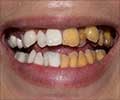A collaborative study conducted by Australian and Taiwani researchers has led to a novel way to analyse the health of human teeth using lasers.
Described in the open-access journal Optics Express, the new approach involves measuring how the surface of a tooth responds to laser-generated ultrasound, which can help evaluate the mineral content of tooth enamel-the semi-translucent outer layer of a tooth that protects the underlying dentin.This is the first time that any research team has been able to non-destructively measure the elasticity of human teeth, creating a method that can be used to assess oral health and predict emerging dental problems, such as tooth decay and cavities.
"The ultimate goal is to come up with a quick, efficient, cost-effective, and non-destructive way to evaluate the mineralization of human dental enamel," says David Hsiao-Chuan Wang, a graduate student at the University of Sydney in Australia and first author on the paper.
For research purposes, "nano-indentation" is commonly used for gaining information on the elasticity of tooth enamel-a measure of its mineral content. However, nano-indentation destroys the measured regions of the enamel in the process and is only used to look at extracted teeth.
Wang and his advisor Simon Fleming, a physics professor at the University of Sydney's Institute of Photonics and Optical Science, said that they wanted to develop a clinical method that would give as much information as nano-indentation and could be used to assess tooth enamel in actual patients while being completely non-destructive.
So, added the researchers, they developed a way to measure the elasticity of tooth enamel by adapting laser ultrasonic surface wave velocity dispersion, a method similar to what industrial engineers use to evaluate the integrity of thin films and metals.
Advertisement
The velocity of these waves is influenced by the elastic properties of the enamel on a tooth, and by detecting the ultrasonic waves with fibre optics at various points, they can determine the enamel's elasticity, which is directly related to its mineralisation.
Advertisement
They admit that they have not yet tested the technique on a living person's teeth, and that it will likely take several years before any eventual device is ready for use in the dentist's office.
Source-ANI
SRM










